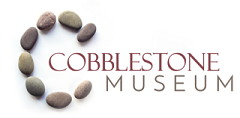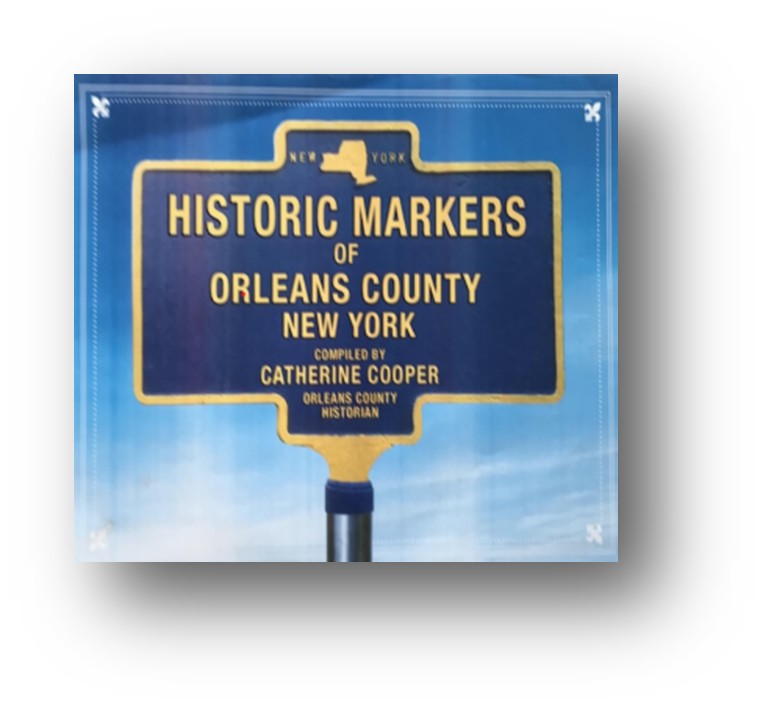This amazing collection of over 20 coverlets owned by Orleans County families is currently on display and available for daily viewing. Call for Appt. 585-589-9013. Full color catalog available.
The Gallery & Exhibit
The Cobblestone Society & Museum acquired its Visitors Center late in 2021. The historic red brick edifice was built in the 1830s and remained in private hands until 2021. The first owner and builder was a member of the Proctor family, founding fathers of the hamlet they created. The “Orleans County Coverlet Exhibit” is the first exhibition utilizing the rooms on the second floor of the now Thompson-Kast Visitors Center. The 21 coverlets were originally owned by Orleans County residents and later donated to the Museum. They are displayed, mainly full size, in four upper gallery rooms. The coverlets date from 1835-1847 and include a wide range of structure types, weaves and patterns. Let us also note that in a fifth gallery room there is an exhibit of Victorian Paintings by Local Artists.
Foreword
During the first half of the 19th century, most communities in central and western New York hosted professional weavers. They were considered professional because they practiced the trade to earn most or all their living. Households typically had a loom in their home as well, on which some of their utilitarian textiles were woven. These textiles were woven from wool or linen that was produced on the farm. Towels, bed sheets, tablecloths, and fabric to make clothes were some of the items that were homespun and woven in the home. The professional weavers also produced utilitarian textiles, but they had specialty items they wove to sell as well. The specialty textiles required additional equipment and greater skill on the part of the weaver.
Coverlets were one of those special items that a professional weaver might weave. Coverlets are woven bedcovers. They were practical as well as decorative. A coverlet is distinguished from a quilt in that a coverlet was woven and a quilt was made of fabric pieces that were stitched together, with wool or cotton batting between a top and bottom layer and then the 3 layers were held together by quilting. A coverlet is additionally distinguished from a woven blanket by having a border pattern different than the centerfield pattern and coverlets often had distinctive corner blocks as part of the woven pattern. Some types of coverlets were woven in the home as well as in the professional weave shop. These coverlets did not require special equipment and often had a weave structure known as overshot or float work. The patterns produced were sometimes quite complex, but were essentially geometric.
Some professional weavers had special loom attachments that would enable them to weave patterns that included floral figures, animals, buildings, and other fancier imagery. In addition to fancy images, the loom attachments also allowed the weavers to weave letters and numbers into the textiles. It became common practice to personalize the coverlet by weaving into the corner block some combination of date, placename, client’s name, and/or weaver’s name. These coverlets are often referred to as ‘figured and fancy’ coverlets, to distinguish them from ‘geometric’ coverlets.
Coverlets were usually woven of wool and cotton. The wool was likely produced locally and spun into yarn in the home. The cotton yarn was available to purchase in the local general store. The cotton was usually natural or bleached white. The wool was dyed, in the home or by the coverlet weaver, with blue being the most common color in New York, though red was not unusual.
Central and western New York abounded with professional weavers in the 1830s and 1840s. There were at least two professional coverlet weavers in Orleans County. There were likely more, who have not been documented.
The coverlets in this exhibit date from 1836-1848. Thirteen of the coverlets are inscribed ORLEANS COUNTY. The Orleans County coverlets in 1847 and 1848 are also inscribed D. P. JOHNSON WEAVER. Research to date has not uncovered who Johnson was. He is likely the weaver of coverlets woven from 1835-1846 which do not have a weaver’s name included. Perhaps Johnson added his name in 1847 and 1848 because another coverlet weaver appeared in the county. J. Shearman/Sherman was a weaver in Livingston County with known coverlets dating from 1836-1844. But there are also known coverlets by J. Shearman inscribed KENDALL MILLS, an Orleans County hamlet. J. Shearman apparently wove in Kendall Mill in 1846-1847 and added his name J. SHEARMAN to the corner block of his coverlets. Perhaps this is what prompted D. P. Johnson to add his name to the coverlets he wove in 1846 and 1847.
Coverlets were often woven with a client’s name woven in. The name is usually female, often a gift to a young woman before being married. As a general rule, most professional coverlet weavers were men and most recipients of coverlets were women.
Kudos to Bill Lattin for recognizing the merit of pulling together the coverlets in the Cobblestone Museum collection and installing the exhibit. It is a noteworthy collection of coverlets woven in Orleans County or having a long-term connection to the county. Both geometric patterned coverlets and figured and fancy coverlets are well represented in the collection. Coverlets were utilitarian in that they were used for warmth, but were also decorative, when displayed as the top-most bedcovering on an early settler’s bed. Today we can view coverlets that are almost 200 years old because these fancy coverlets were highly valued and carefully passed down through the generations as heirlooms.
I would like to acknowledge assistance I received in working with this collection. Cassie Dickson, a North Carolina weaver and dyer, graciously researched the names of the patterns on the geometric coverlets. Cheryl Van Denberg of the Alling Coverlet Museum in Palmyra has aided me in my coverlet research. Ron Walter, a Pennsylvania coverlet collector, and researcher who shares his findings and from whom I’ve learned a lot.
Enjoy these 19th century treasures.
Marty Schlabach
Interlaken, NY




